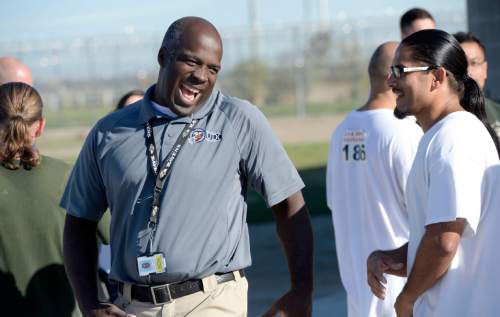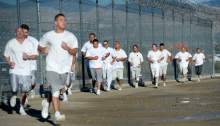This is an archived article that was published on sltrib.com in 2015, and information in the article may be outdated. It is provided only for personal research purposes and may not be reprinted.
As they seek a new home for the state prison, legislative leaders have long said they will try to find land close to where corrections officers and the institution's many volunteers now live.
That prospect appears to be waning as the Prison Relocation Commission takes a serious look at property farther away from the metro area.
"This is a 100-year decision. You have people who are not even born yet who are going to work there," said House Speaker Greg Hughes, who represents Draper, where the current prison is located. "I'm not going to limit our scope to where they are now."
Hughes, a former member of the commission, favors relocating the penitentiary to a more remote part of Tooele County. Consultants hired by the state are in the process of scouting some land there and in parts of Utah County, near Five Mile Pass. Carbon and Emery counties are also interested.
Adding a lengthy commute could result in a loss of experienced officers and a drop in the diversity of volunteers.
"The farther away from where it is, the more volunteers will be lost," said Pat Buniva, a prison volunteer with the Catholic Diocese. "You can't put a price tag on that. It will hurt inmates."
Officers and volunteers do not generally live in the same areas of the state.
The Department of Corrections provided The Salt Lake Tribune the home ZIP codes for the 750 employees of the Division of Institutional Operations, which includes all corrections officers. Only 10 of them live in Draper. Most of the prison employees tend to reside in cities to the west and south, places like Bluffdale, Lehi and Pleasant Grove.
The department also provided ZIP codes for 1,000 active volunteers. The biggest group, 110, live in Draper, followed by nearby Riverton and South Jordan. Then there are major clusters all along the Salt Lake Valley's east bench, places such as Holladay and Cottonwood Heights.
—
LDS calling • The volunteer numbers are heavily influenced by the LDS Church. Through church assignments, known as callings, The Church of Jesus Christ of Latter-day Saints sends hundreds of its members to the prison to help inmates with everything from religious worship to drug treatment and genealogy. As might be expected, the faith relies on the congregations closest to the prison for most of these volunteers.
Church authorities have told the commission they will continue to call members to serve at the prison and should be able to maintain the volunteer numbers as long as a new site is in the vicinity of three to four LDS stakes, which are collections of congregations.
It's not so easy for many of the state's other religious groups who offer prison services, ranging from Buddhists to Baptists to Muslims, which have smaller congregations. Nor is it as easy for other organizations that provide volunteers.
Every Tuesday and Wednesday, for example, volunteers with Canines with a Cause travel from Salt Lake City and Wasatch County to Draper to teach female prisoners how to train dogs. The pets live with the inmates, with two women sharing custody of a dog. Each weekend, a volunteer picks up the animals and brings them to a foster home so they can enjoy a more comfortable environment. During the week, the pets live at the penitentiary.
Cathy King, executive director of Canines with a Cause, believes the programs have helped the incarcerated women gain confidence and maturity, and she hopes to expand into the men's prison. But if the state builds a new facility outside of the metro area, she's not sure if the program will survive.
Thinking of her members who live in Wasatch County, she said: "They are definitely not going to drive out to Tooele two days a week, especially as volunteers who are paying for their own gas."
King said she would try to recruit people wherever the prison moves, but she hopes it doesn't come to that.
"I know the volunteers who do yoga and the religious services, it is going to impact everybody," she said.
—
Winnowing • Striving to maintain this essential pool of active volunteers, the commission heavily weighted the proximity to the Draper prison when sifting through more than two dozen potential sites late last year. Consultants also reviewed staff ZIP codes. Their selection process winnowed sites to six finalists, including land near residential areas in West Jordan and Saratoga Springs.
Local elected officials and community groups opposed each of those parcels, holding protests and bombarding the commission with angry emails.
Some commission members, including Hughes, bristled at the recommendations, believing the proximity scores skewed the results in favor of sites that would be better suited for homes or commercial development.
The commission has since changed its criteria. It dropped any scoring for how close land is to the Draper prison (a proxy for where volunteers live) and reopened the property hunt.
Of the original six finalist sites, only three remain under consideration. One is on land west of Salt Lake City International Airport; another is near the Miller Motorsports Park in Tooele County; and the last is in the south end of Eagle Mountain, about three miles from neighborhoods that continue to expand.
The Eagle Mountain site offers some appeal to corrections officers, because so many live in northern Utah County and southern Salt Lake County. The airport site would be most easily accessible to many of the volunteers, particularly the other faith-based groups that tend to live near Salt Lake City. The Tooele County location appears most inconvenient to staff and volunteers.
"The only site that would cause some hardship is the Tooele one," said Vaughn Howard, the president of the Fraternal Order of Police Correction Lodge 14. "You have to go clear around the mountain and it is an hour drive no matter which way you go."
Howard, an employee with Utah's Adult Probation and Parole, said his group has expressed its concern to state lawmakers.
Buniva, one of the Catholic volunteers, goes to the prison twice a week to fellowship and teach, something she's done for the past eight years.
Concerned about the relocation debate, she took a drive from her home in Sandy out to Tooele County to see how long it would take. She said "it could work," but she hopes the Legislature keeps the prison where it is, right off of Interstate 15. And not just for the sake of convenience — she believes a society shouldn't keep its prisoners out of sight.
"I tell people when you drive by that prison what you really need to be aware of is how many people have found God there because they have hit bottom," she said. "Having support is really important for them, to have a community that cares."
—
Prison-site hunt • Sen. Jerry Stevenson, R-Layton, a co-chairman of the commission, says state leaders remain committed to finding a new prison site, but recognize that it's a difficult balancing act. He noted the farther away the prison is built, the more difficult it would be for family members to visit an inmate, and it may increase the costs of regular deliveries to the prison.
Still, he said the commission and the Legislature won't focus solely on the immediate impacts, suggesting that people often move for a job.
"If we are looking for the 100-year facility, we may be looking for a site farther out," he said.
The next step in the selection will take place on Feb. 27, when the commission holds its next meeting. Commission members say it is possible that they will add some of these more remote sites to the list of finalists at that time. If so, those sites would then undergo a more thorough technical review, with the commission likely to take several months to narrow the list.
Twitter: @mattcanham
Tony Semerad contributed to this report.





